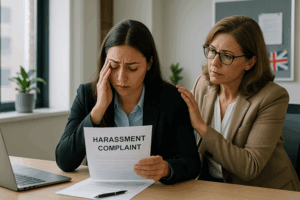How to prove sexual harassment at work?

A lingering look, an inappropriate comment, then a growing sense of discomfort. Sexual harassment at work often starts subtly yet proves deeply damaging. Under the Equality Act 2010, it covers any unwanted sexual conduct that violates dignity or creates hostile environments. Many hesitate to act due to lack of proof or fear of consequences. When in doubt, consult a solicitor specialising in workplace harassment to build winning sexual harassment cases.

Key Takeaway: How can you prove sexual harassment when it’s often subtle and hard to document?
This guide provides systematic steps to prove sexual harassment misconduct and secure justice through proper legal channels.
Step 1 – Identifying behaviours that constitute sexual harassment misconduct
Before proving sexual harassment misconduct , you must understand which behaviours fall under legal protection. UK law, specifically the Equality Act 2010, protects anyone subjected to unwanted conduct of a sexual nature, whether verbal, physical, non-verbal, or electronic.
Sexual harassment examples include:
- Verbal behaviours: sexual comments, inappropriate jokes, remarks about appearance or private life, persistent propositions or advances.
- Non-verbal behaviours: staring, suggestive gestures, displaying sexual images or materials in workplace environments.
- Physical behaviours: unwanted contact, brushing, touching, or even assault.
- Electronic sexual harassment examples: sending sexual messages, photos, or videos via email, text, or workplace communication platforms.
Sexual harassment misconduct may be committed by colleagues, managers, subordinates, clients, suppliers, or any person present in workplace environments, regardless of hierarchical relationships or employment status.
Step 2 – Gathering bulletproof evidence for sexual harassment cases
Proving sexual harassment cases at work largely depends entirely on evidence quality. Since sexual harassment misconduct often occurs without direct witnesses, it is essential to carefully gather all elements that can support your account.
- Document every incident immediately by recording date, time, and exact location of each incident, providing clear and objective descriptions of what occurred including words, gestures, and messages received, noting names of anyone present or potential witnesses, and recording your immediate emotional response including stress, fear, or embarrassment. Consistent, detailed diaries often become key evidence in sexual harassment cases, especially when harassment occurs over extended periods.
- Preserve all written and digital materials by saving emails, text messages, or workplace platform communications, taking screenshots of conversations or sexually explicit content, collecting any objects, gifts, or documents with sexual connotations received at work, and storing materials outside work computers or email systems on secure personal devices like USB drives or private cloud storage.
- Collect comprehensive witness statements by approaching colleagues who may have noticed inappropriate behaviour or overheard comments, requesting dated written statements describing their observations, and ensuring testimonies strengthen your case during internal investigations or sexual harassment tribunal
Step 3 – Organising and securing your evidence
Once evidence is gathered, systematic organisation and security protection becomes essential for sexual harassment cases success. Clear presentation helps investigators and tribunals understand your case during proceedings.
- Arrange documents chronologically to demonstrate harassment patterns and ongoing impact over time, creating clear timelines that show escalation or persistence of sexual harassment misconduct.
- Create separate, secure files by storing all evidence in dedicated digital and physical files separate from regular work documents, using personal secure devices such as USB drives, external hard drives, or password-protected private cloud storage to safeguard materials.
- Protect evidence confidentiality by avoiding storage on employer-owned devices or accounts to preserve privacy and prevent accidental deletion or alteration, sharing materials only with trusted individuals who can support you throughout the process.
Step 4 – Officially reporting harassment through proper channels
After gathering and organising evidence, submit formal complaints to your employer so sexual harassment misconduct can be addressed through proper internal procedures.
- Identify appropriate reporting contacts including your direct line manager, Human Resources department, or designated harassment officer responsible for anti-harassment policy within your organisation, following established internal procedures where they exist.
- Submit clear, precise complaints that include factual descriptions of incidents with dates, times, and locations, all collected evidence and witness information, impact the harassment has had on your work and wellbeing, and specific remedies or protection sought. Submit written complaints preferably by email or registered letter to maintain evidence of your action.
- Expect proper employer response as employers are legally obligated to investigate promptly and take protective action, ensuring confidentiality and workplace safety while addressing sexual harassment misconduct through appropriate disciplinary measures.
Step 5 – Taking your case to sexual harassment tribunal
If internal complaints fail to resolve issues or you remain unsatisfied with employer responses, sexual harassment tribunal proceedings provide formal legal remedies to assert your rights.
- Complete mandatory ACAS early conciliation before filing sexual harassment tribunal claims, as ACAS offers free mediation services to help reach agreements with employers, potentially avoiding lengthy and costly court processes while preserving your legal rights.
- File comprehensive tribunal claims using ET1 forms if conciliation fails or proves inappropriate for your circumstances. Claims must be lodged within three months of the last harassment act or conclusion of internal processes, with strict deadlines that tribunals rarely extend.
- Understand potential tribunal outcomes as sexual harassment tribunal proceedings may find harassment occurred and order financial compensation for harm suffered, disciplinary sanctions against harassers, and corrective measures requiring employers to prevent future incidents. This formal legal process benefits significantly from professional legal representation to improve success prospects.
Step 6 – Do I need a solicitor to prove sexual harassment misconduct?
Specialist employment solicitors provide comprehensive support throughout sexual harassment cases, from initial complaint drafting through sexual harassment tribunal representation and beyond:
- Expert case preparation includes drafting and reviewing internal complaints or formal tribunal claims with strong legal grounding, analysing evidence strength and identifying additional supporting materials, developing strategic approaches tailored to your specific circumstances, and calculating appropriate compensation demands based on legal precedents.
- Professional negotiation and representation involves liaising with HR or management to pursue amicable dispute resolution, representing you during sexual harassment tribunal hearings with skilled advocacy, presenting evidence and legal arguments effectively to maximise success prospects, and ensuring your rights receive full protection throughout proceedings.
- Ongoing comprehensive support provides guidance through each process stage with clear explanations of legal issues, moral support during difficult experiences, and strategic advice on settlement opportunities versus continued litigation based on case strength and personal circumstances.
FAQs
- Can I file a sexual harassment complaint without direct evidence? Your testimony can prove sufficient in sexual harassment cases, especially when consistent and supported by indirect elements like behavioural changes or witness statements. Document incidents immediately for strongest evidence.
- What protection exists against retaliation after reporting harassment? UK law protects victims from retaliation including dismissal, sidelining, or demotion. Discriminatory treatment following complaints creates additional legal claims for protection and compensation.
- How long do sexual harassment tribunal cases typically take? Sexual harassment tribunal duration varies by complexity but generally requires several months to one year from filing to final judgment, with case management conferences and evidence exchange extending timelines.
Proving sexual harassment cases at work requires diligence, methodical evidence gathering, and proper organisation. Don’t hesitate to seek support from a specialist workplace harassment solicitor to effectively defend your rights and maximise your prospects of justice.
Build your winning sexual harassment misconduct case!
When sexual harassment misconduct threatens your workplace dignity, Qredible’s network of specialist employment solicitors knows exactly how to build compelling sexual harassment cases that succeed.
KEY TAKEAWAYS
- Document every incident systematically by keeping detailed records and preserving all related communications, as this evidence forms the foundation of successful sexual harassment cases.
- Understanding sexual harassment examples and recognising behaviours protected by law helps identify and prove sexual harassment misconduct in workplace environments.
- Following employer internal procedures through official reporting remains essential before escalating matters to sexual harassment tribunal proceedings.
- Seeking specialist legal support early significantly increases prospects of successful outcomes in sexual harassment cases through expert evidence preparation and tribunal representation.
Articles Sources
- legislation.gov.uk - https://www.legislation.gov.uk/ukpga/2010/15/contents
- acas.org.uk - https://www.acas.org.uk/sexual-harassment
- gov.uk - https://www.gov.uk/employment-tribunals
Do you need a solicitor?
Find a solicitor on Qredible in just a few easy steps
















